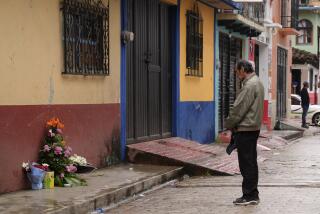Guatemalan Bishop Who Detailed Abuses Is Killed
GUATEMALA CITY — The Roman Catholic bishop who supervised a recently published study of human rights abuses committed here in three decades of a U.S.-backed conflict has been brutally killed--a reminder of the bloody violence that plagues this nation after decades of civil war.
An assailant crushed Bishop Juan Jose Gerardi’s skull with a concrete block as the cleric, returning from dinner with his sister, entered his house at 11 p.m. Sunday, church officials said. The 75-year-old coordinator of the Guatemalan Archbishop’s Office of Human Rights was hit 14 times on the back of the head and on his face. Nothing was stolen.
A statement released Monday by the human rights office gave the government 72 hours to clear up the crime, because “if impunity is allowed to extend to this case, the cost for Guatemala will be high.”
Police had found a witness and were looking for a suspect based on a composite drawing.
President Alvaro Arzu appointed a high-level commission--composed of the interior minister, the president of the National Human Rights Commission and his personal assistant, as well as members chosen by the church--to investigate the slaying. “All the resources of the nation will be used to solve this crime,” he told a national television audience. His entire Cabinet accompanied him in the broadcast.
United Nations Secretary-General Kofi Annan condemned the killing “in the strongest terms.” The United States said it deplored the “senseless act of violence” and called on Guatemala to begin a full investigation. And the Catholic Bishops’ International Policy Committee called the slaying a “terrible shock” and “despicable crime.”
Authorities in this crime-ridden nation have not provided a motive for the killing. But for those who worked with Gerardi, the reason was clear. “This was a blow against the peace process,” said Guatemalan human rights activist Hellen Mack. “For them to have killed a bishop--which they did not even dare to do during the war--shows how far [some people] are willing to go to stop the peace process.”
*
Gerardi initiated and directed the Roman Catholic Church’s Historical Memory Recovery project, a three-year study of human rights abuses committed in the civil war that ended with a peace agreement in December 1996. Released Friday, the 1,400-page study, “Never Again,” compiled 6,500 interviews, many in 15 Mayan languages.
It was the first attempt to document atrocities committed in the 35-year conflict between communist guerrillas and the government here, which except for the last years of the war was made up of U.S.-backed military dictators.
The church report agreed with many scholars that although the war began in the early 1960s, it had roots in the 1954 CIA-backed coup that deposed democratically elected President Jacobo Arbenz.
The rebellion was supported by many of the poor in the Maya highlands. Military dictators initiated a scorched-earth policy in the early 1980s, killing thousands of Indian peasants and driving thousands more from their homes to eliminate the rebels’ sources of supplies.
Among the legacies of this war and similar conflicts in the region was the creation of a huge refugee population in Southern California--an estimated 250,000 Salvadorans and Guatemalans.
The conclusion of years of strife also left Guatemala awash in poverty, unemployed soldiers and too many weapons--all contributing to a postwar epidemic of crime.
During the war, brutal government censorship prevented investigations into more than 400 massacres committed by insurgents, the armed forces and private armies sympathetic to them. Since the conflict ended, civilian groups have increasingly demanded accountability for human rights abuses committed by all sides.
Currently, 25 soldiers are on trial for a massacre at Xaman in 1995, the first time members of the military have been tried for mass murders committed during the conflict.
The church report found that 200,000 people died or disappeared during the war, a figure 60,000 higher than previous estimates. The report also stated that 90% of those killed were unarmed civilians; 75% of the victims were Mayas. The guerrillas of Guatemalan National Revolutionary Unity committed 10% of the atrocities; the rest were the fault of the armed forces and armed groups that backed them, the report found.
During most of the war, Gerardi was bishop of Verapaz and, later, Quiche. Both are predominantly Maya provinces. He was an outspoken advocate of human rights, publicly denouncing the slayings of priests and lay workers. He was forced into exile in Costa Rica from 1980 to 1984; he returned to Guatemala as auxiliary bishop to the archbishop of Guatemala City and founded the human rights office.
*
To mourn Gerardi and to draw attention to the government investigation of his death, the human rights office has announced a permanent vigil in the Metropolitan Cathedral until his burial Wednesday and a silent pilgrimage tonight.
Dr. Robert Kirschner of Physicians for Human Rights will participate in the bishop’s autopsy at the request of the human rights office.
Speaking of the slain cleric’s leadership, Edgar Gutierrez, who worked with the bishop on the human rights project, observed: “This crime takes us back to the past again, telling us that this nightmare refuses to end.”
More to Read
Sign up for Essential California
The most important California stories and recommendations in your inbox every morning.
You may occasionally receive promotional content from the Los Angeles Times.










